
The Drottningholm Palace is the private residence of the Swedish royal family. Drottningholm is near the capital Stockholm. Built on the island Lovön, it is one of Sweden's Royal Palaces. It was originally built in the late 17th century, and it served as a regular summer residence of the Swedish royal court for most of the 18th century. Apart from being the private residence of the Swedish royal family, the palace is a popular tourist attraction.
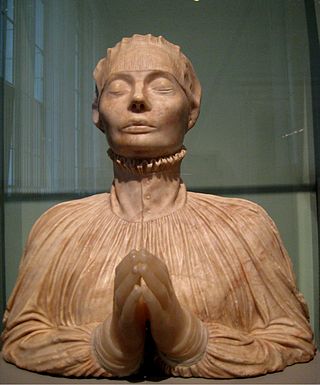
Cornelis Floris or Cornelis (II) Floris De Vriendt was a Flemish sculptor, architect, draughtsman, medallist and designer of prints and luxury. He operated a large workshop in Antwerp from which he worked on many large construction projects in Flanders, Germany and Denmark. He was one of the designers of the Antwerp City Hall. He developed a new style, which was informed by Flemish traditions, the 16th century Italian renaissance and possibly the School of Fontainebleau. His innovations spread throughout Northern Europe where they had a major influence on the development of sculpture and architecture in the 16th and early 17th centuries.
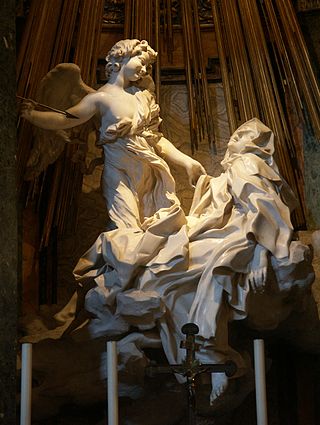
Baroque sculpture is the sculpture associated with the Baroque style of the period between the early 17th and mid 18th centuries. In Baroque sculpture, groups of figures assumed new importance, and there was a dynamic movement and energy of human forms—they spiralled around an empty central vortex, or reached outwards into the surrounding space. Baroque sculpture often had multiple ideal viewing angles, and reflected a general continuation of the Renaissance move away from the relief to sculpture created in the round, and designed to be placed in the middle of a large space—elaborate fountains such as Gian Lorenzo Bernini‘s Fontana dei Quattro Fiumi, or those in the Gardens of Versailles were a Baroque speciality. The Baroque style was perfectly suited to sculpture, with Bernini the dominating figure of the age in works such as The Ecstasy of St Theresa (1647–1652). Much Baroque sculpture added extra-sculptural elements, for example, concealed lighting, or water fountains, or fused sculpture and architecture to create a transformative experience for the viewer. Artists saw themselves as in the classical tradition, but admired Hellenistic and later Roman sculpture, rather than that of the more "Classical" periods as they are seen today.

Artus Quellinus the Elder, Artus Quellinus I or Artus (Arnoldus) Quellijn was a Flemish sculptor. He is regarded as the most important representative of the Baroque in sculpture in the Southern Netherlands. He worked for a long period in the Dutch Republic and operated large workshops both in Antwerp and Amsterdam. His work had a major influence on the development of sculpture in Northern Europe.

Rombout Verhulst was a Flemish sculptor and draughtsman who spent most of his career in the Dutch Republic. An independent assistant of the Flemish sculptor Artus Quellinus the Elder in the sculptural decoration project for the new town hall in Amsterdam, he contributed to the spread of the Baroque style in Dutch sculpture. He became the leading sculptor of marble monuments, including funerary monuments, garden figures and portraits, in the Dutch Republic.

Willem Boy was a Flemish painter, sculptor, and architect active in Sweden from around 1558 until his death.

Hubertus Quellinus or Hubert Quellinus was a Flemish printmaker, draughtsman and painter and a member of the prominent Quellinus family of artists. His engravings after the work of his brother, the Baroque sculptor Artus Quellinus the Elder, were instrumental in the spread of the Flemish Baroque idiom in Europe in the second half of the 17th century.

Cornelis van der Meulen or Cornelis Vermeulen, was a Dutch painter who after training in the Dutch Republic had a career in Sweden where he became a court painter. He is known for still lifes of flowers and game, trompe-l'œil and vanitas still lifes, topographical views and portraits.
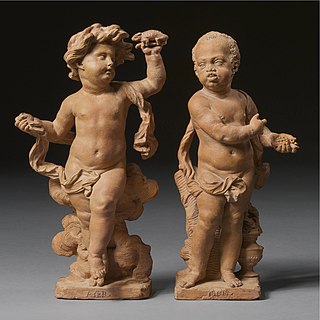
Jan Claudius de Cock was a Flemish painter, sculptor, print artist and writer. De Cock produced both religious and secular sculpture on a small as well as monumental scale. De Cock completed many commissions in the Dutch Republic. He worked on decorations for the courtyard of the Breda Palace for William III, King of England, Ireland, and Scotland and stadtholder. He is credited with introducing neoclassicism in Flemish sculpture. He was a prolific draughtsman and designed prints for the Antwerp publishers. As a writer, he wrote a poem about the 1718 fire in the Jesuit Church in Antwerp and a book of instructions on the art of sculpture.

Peter Ykens, was a Flemish painter mainly known for his history paintings and portraits. He regularly collaborated with specialist still painters and landscape artists for whose works he provided the staffage.

Pieter Scheemaeckers, Pieter Scheemackers, Pieter Scheemaeckers I or Pieter Scheemaeckers the Elder was a Flemish sculptor who played an important role in the development of Baroque church sculpture in the late 17th-century Habsburg Netherlands. He was also known for his marble funerary monuments an small scale ivory works. He was the father of Peter Scheemakers who became a leading sculptor of portraits and church monuments in 18th century London.

Abraham César Lamoureux was a French sculptor and stonemason who worked in Sweden and in Copenhagen, Denmark. He is best known for creating the first equestrian statue in northern Europe.
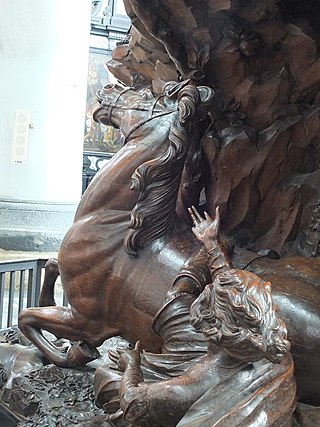
Michiel van der Voort the Elder, Michiel van der Voort (I) or Michiel Vervoort the Elder, nickname Welgemaeckt (Antwerp, 3 January 1667 – Antwerp, buried on 8 December 1737) was a Flemish sculptor and draftsman, who is best known for the Baroque church furniture which he made for the principal churches in Flanders. He also produced secular works, particularly of mythological and allegorical subjects. His work expresses both late Baroque exuberance and the quest for the simplicity of Classicism. His oeuvre shows the influence of Michelangelo, François Duquesnoy and Rubens. He trained many members of the next generation of Flemish sculptors.

Lodewijk Willemsens or Ludovicus Willemsens (1630–1702) was a Flemish sculptor from Antwerp. His works comprise mostly sculptured church furniture, and to a lesser extent individual sculptures, both portrait busts as well as statues of saints for churches.

Willem Kerricx or Willem Kerricx the Elder was a Flemish sculptor active in Antwerp. His works comprise mostly sculptured church furniture, individual sculptures, both portrait busts as well as statues of saints for churches and funerary monuments. His style shows the transition from the highly dramatic expressiveness of the Antwerp late Baroque towards a more gracious and elegant Rococo style. He operated a large workshop in Antwerp which was continued by his son into the middle of the 18th century.

Gaspar van der Hagen or Gaspar Vanderhagen was a Flemish sculptor and ivory carver. It is possible he should be identified with the ivory carver signing his works with the monogram G. VDR. He is only known for his work created during his stay in England where he was an assistant in the workshop of the prominent Flemish sculptor John Michael Rysbrack. He is known for his portrait busts and portrait medals carved in ivory.

Alexander van Papenhoven was a Flemish sculptor, architect and art educator, who is best known for the church furniture which he made for the principal churches in Flanders. He worked mainly in Antwerp, but early in his career he was also active for some years in Denmark.
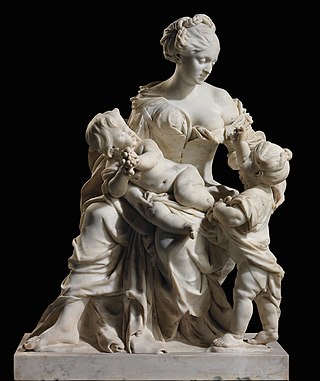
Jan van Delen was a Flemish sculptor who is mainly known for his Baroque church sculptures, allegorical scenes, funeral monuments and portraits. He was principally active in Brussels where he popularized the Flemish Baroque style in sculpture.

Bartholomeus Eggers was a Flemish sculptor, who after training in his hometown Antwerp spent most of his active career in the Dutch Republic. Here he initially collaborated with other Flemish sculptors on the sculptural decorations for the new city hall in Amsterdam, a project which was under the direction of Artus Quellinus the Elder. He worked on various public projects and on commissions for leading courts in Europe. He is known for his portraits, funerary sculptures, reliefs, statues of children and allegorical, biblical and mythological sculptures. He was, together with Artus Quellinus the Elder and Rombout Verhulst, one of the leading sculptors active in the Dutch Republic in the second half of the 17th century.

Albert Xavery, Albert Saverij or Albertus Xavery was a Flemish sculptor principally active in Antwerp. He produced mainly statues of mythological figures, some of them on a large scale, made to be displayed in luxurious residences or in gardens. Like other Antwerp sculptors, he exported many of his works to the Dutch Republic, where his patrons included members of the House of Nassau.
























